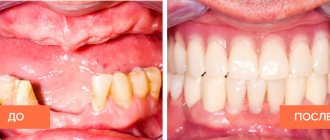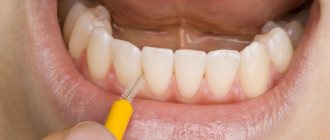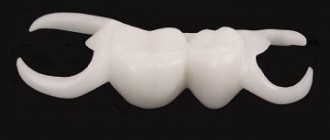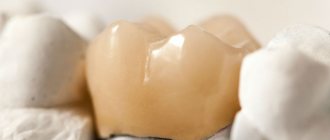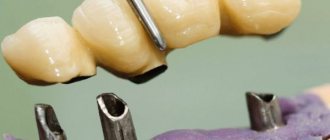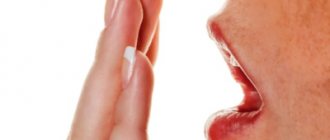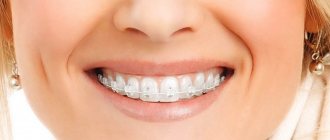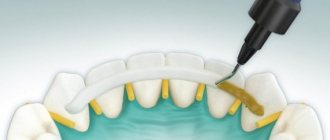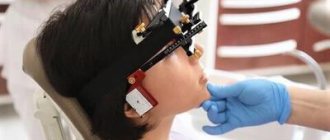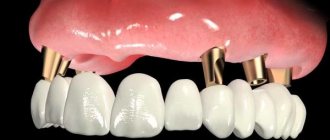The loss of all teeth, regardless of the reasons, is not only an aesthetic nuisance, but also a condition that subjugates the patient’s entire future life. There are usually two ways to solve this problem: implantation and dental prosthetics. The first option is traditionally considered the most aesthetic and durable. It skillfully replaces the “native” row of teeth, attaching directly to the jaw bone. Prostheses, on the other hand, are more mobile; in most cases, they have a removable design, which allows you to quickly adapt to changing physiological characteristics. They have also become a panacea for those for whom operations and surgical interventions are contraindicated.
Clinical case: edentia
This disease causes complete or partial loss of elements of the dental arch due to the occurrence of defects in the jaw system. Most often it occurs in elderly people, pensioners and is associated with the aging process of the body, however, in practice, young patients and even children have been recorded.
Causes of the disease
When studying adentia, it was revealed that it can be primary and acquired.
Tooth loss, which is caused by congenital causes, is usually a consequence of exposure to negative factors that prevented the formation of a dental plate during fetal development. Sometimes it is caused by a genetic disorder, which also negatively affects the formation of skin, hair, some exocrine glands, nerve tissue and even the lens. In this case, edentia is the lesser of the evils, but such pathologies are rare in practice and practically cannot be corrected.
The secondary form, as already noted, may be associated with age-related changes that overtake a person during the life cycle, but also develop against the background of other pathogenic processes in the oral cavity. Dentists identify the following as dangerous pathologies:
- deep caries;
- pulpitis (inflammation of the internal tissues of the tooth);
- periodontitis (inflammation of the gums), which has developed into a chronic form;
- periodontitis (an inflammatory process that affects the tissues that hold the tooth in the alveolus);
- odontogenic osteomyelitis (an inflammatory disease that develops in the jaw bones);
- periostitis (inflammation of the periosteum);
- incorrect deletion;
- serious injury, etc.
Many of the diseases listed are quite easy to treat in the initial stages, however, if they are neglected, they lead to disastrous consequences, the elimination of which will require you to shell out a large sum.
Diagnosis and symptoms
Congenital adentia appears already on baby teeth. This causes changes in the anatomy of the skull, affects the structure of the face, in particular, it is characterized by a reduction in the lower jaw, anhidrosis, absence of eyelashes and eyebrows, and skin abnormalities. This is all associated with a complex of genetic abnormalities and is diagnosed at an early age. Such patients experience lifelong problems with chewing, unclear diction and difficulty breathing.
In simpler, acquired forms, there are no such obvious manifestations, but the dentist can easily identify a possible patient without an examination in the chair. Their lower jaw shifts towards the nose, the nasolabial triangle settles, and the number of wrinkles increases due to the weakening of the muscle frame. After some time, lack of load starts the process of degradation of the jaw bone tissue, which can then only be restored through surgery.
Diagnosis does not require special devices and a visual examination of the oral cavity is sufficient. Complete or partial absence of teeth is a sure sign of disease. Sometimes radiography, computed tomography and other medical examination methods are additionally used, which provide the doctor with additional information about the patient’s condition.
When there is no point in saving teeth, they resort to radical measures and use prosthetics as a universal way to preserve beauty and youth even under such circumstances.
Missing teeth in the lower jaw
The long-term absence of lower teeth, in addition to purely psychological problems, often leads to quite material and significant changes in the bone tissue of the jaw and the appearance of a person, in particular:
- Neighboring teeth begin to shift towards the missing ones, this leads to curvature of the dentition, the formation of gaps or a shift in the location of the longitudinal axes of the teeth, and occlusion is disrupted - the closure of the jaws. The antagonist tooth also moves towards the missing one. In the absence of a large number of teeth, a pronounced violation of the tone of the masticatory muscles occurs, which can result in pathology of the temporomandibular joint.
Due to the lack of load on the bone tissue of the jaw, its blood supply and nutrition deteriorate, this leads to a weakening of the structure of the bone tissue of the alveolar process. At the same time, the cheeks fall inward, and the oval of the face changes. In the absence of front teeth, the lips begin to collapse, the nasolabial fold becomes more pronounced, and the corners of the mouth droop. All this leads to loss of muscle tone and the formation of signs of aging.
- In addition to external changes, in the absence of teeth, a violation of diction is often noted. This is due to incorrect articulation when pronouncing certain sounds. Impaired diction is also facilitated by the fact that the tongue, which is no longer limited in size by the teeth, begins to enlarge.
- Poor chewing of food in the absence of teeth can cause the development of diseases of the entire digestive system. Insufficiently chewed food is poorly digested in the stomach, and this, in turn, leads to incomplete absorption of the nutrients, vitamins and microelements necessary for our body, which cannot but affect the immune system.
- Interesting fact: Japanese scientists at the Tohoku Institute have established a direct correlation between tooth loss in old age and a decline in intelligence: as the number of teeth decreases, the volume of brain tissue in the hippocampus decreases. The hippocampus is a gyrus located in the temporal lobes. This share is involved in storing and processing information. One of the hypotheses is that during the process of chewing food, reflex stimulation of brain cells occurs. When chewing does not occur for some reason, for example, when using soft and ground food, such brain stimulation does not occur. In this regard, it is important to restore not only the aesthetic component of the dentition, but also the functional one.
Read also: What to do if your child grinds his teeth
Possibilities of removable dentures in the absence of all teeth
Possibilities of removable dentures in the absence of all teeth
Let us immediately note that they are practically limitless. Due to the fact that the market offers a wide range of different types of fastening and base materials, you can choose a removable denture to suit any needs and individual characteristics. Somatology has made great progress, so complete dental prosthetics can be safely carried out on both the lower and upper jaws, without fear of damaging the sinuses and sinuses. In the modern world, missing teeth is not a problem, but just temporary difficulties.
Prosthetic options for complete absence of teeth
A removable denture on the upper or lower jaw traditionally competes with implants. Doctors usually recommend resorting to implantation, but the effectiveness of prosthetics is sometimes undeniable. The main argument for patients of clinics in Moscow, St. Petersburg and other cities is the affordable price of a removable denture in the absence of teeth.
Types of removable dentures
They differ largely in the principle of attachment in the oral cavity. There are three main categories:
- Partially removable dentures. They are fixed with clasps or attachments, which imply the presence of at least a pair of teeth. Their use is impossible with complete edentia.
- Conditionally removable structures. Their main feature is that they are installed and dismantled only in the dental office; it is impossible to remove them yourself. Implants are secured with screws or specialized cement.
- Fully removable dentures. They are fixed using suction cup systems or specialized adhesives, ointments or gels. They are suitable for complete absence of teeth and are easy to install and maintain. The patient can remove them independently at home.
Unlike fixed structures, they are easily replaced in the event of a chipped crown or other malfunctions, but cannot be repaired. Often their service life is shorter: if a prosthesis with proper care lasts 5-10 years, then implants retain their appearance and functionality for up to 20-30 years.
Advantages of removable prosthetics
This type of restoration of lost teeth has taken root in dentistry due to the variability and variety of forms and dental solutions. On the official websites of dental clinics and offices, as well as on thematic forums, you can find many reviews from real clients who share their experience of wearing removable dentures, confirming their words with photographs. Among the advantages they highlight:
- individual selection of crowns that successfully imitate natural teeth;
- basic care that does not require special equipment or medications;
- versatility, the ability to adapt to the needs of any patient;
- high biocompatibility with soft tissues of the oral cavity and hypoallergenic;
- affordable price and high production speed compared to alternative options;
- possibility of use as temporary structures;
- strength and wear resistance.
Despite the fact that implantology is actively developing, dentists say that removable dentures will not soon become obsolete.
Disadvantages of dentures for edentia
Despite the fact that medicine has made great strides forward, modern removable dentures are widely used to solve the problem of missing teeth due to the fact that they are much better than their predecessor models.
There is no limit to perfection, so some problems remained that could not be solved with the help of technological progress. These include:
- insufficiently reliable fixation and the possibility of unexpected detachment from the fastenings;
- susceptibility to the destructive influence of chemical and mechanical irritants, which affects the appearance, especially during long-term use;
- distortion of the taste of food due to blocking the palate;
- do not inhibit the process of degradation of jaw bone tissue;
- due to the thinning of the bone and the properties of the materials used as a base, the removable denture no longer fits tightly and requires relining, the use of specialized creams and gels for fixation;
- Most base materials can cause irritation, chafing and ulcers upon prolonged contact with the mucous membrane;
- a long adaptation process and the need for training to restore diction;
- the need to follow a diet, completely avoid solid food.
Many unpleasant nuances also apply to fixed structures. They can be avoided if you make the structure correctly, take a responsible approach to caring for it, and also do not neglect regular visits to the dentist. Even a low-quality removable denture, with the proper approach, can compete with some implants.
Alternatives to removable dentures
The main competitor of the described structures are dental implants. In dental practice, they are used to replace both one lost tooth and to reconstruct the entire jaw arch.
Advantages of permanent dental implants:
- the possibility of installation at an angle, which allows their use in cases of bone tissue atrophy;
- due to the thread on the dental pin, there is no need for an incision; installation occurs through a small puncture;
- the ability to repair parts without the need to reissue the entire structure;
- correct distribution of the load on the bone, which slows down and sometimes prevents the process of degradation;
- greater comfort in operation due to a more anatomical design;
- long service life, up to 30 years;
- can be used for patients of any age.
Veneers are widespread today, but they are not suitable for completely edentulous patients.
The method of single artificial teeth can be too traumatic, requiring extensive surgery and a large amount of money. The innovative all-on-4 method, which was developed by Nobel Biocare, is considered to be the optimal solution for edentia.
There are also all-on-3 or all-on-6 variations. It lies in the fact that with just a few fixed implants you can secure 12 or more crowns, which allows you to correct the complete absence of teeth in the upper or lower jaw. Because the technology follows an immediate loading protocol, arch reconstruction is possible in one dental office visit. Fixed basal implantation technology is also used, but it is recognized as less effective in the absence of a large number of teeth than “all-on-4”.
Changes on the face
What determines a person's appearance?
The correct answer is from the teeth, if we are talking about the structure of the face. Shining 32 teeth are an indicator of youth and health. Over time, tooth loss leads to jaw deformation and external changes. A large number of people in the world live without at least one tooth. If its absence is not noticeable at first glance, it clearly affects the future health of the oral cavity. This is not only an aesthetic problem. Well-being, comfort and self-confidence may be the first to suffer. An important aspect of health is bone tissue, which is another side of the issue. It surrounds the tooth and thins over time, changing the shape of the jaw and the appearance of a person.
Bone tissue requires constant stress, which occurs during the process of chewing and biting food. Loss of teeth leads to bone loss and a decrease in its density by a full quarter - 25%, and in the first year. The further, the more: if the tissue is left without load for a long time, the greater the percentage of its loss. That is why dentists and specialists in the field of implantology advise patients not to delay, in case of a problem even with one tooth.
Alexey Yakubov
, certified specialist in the field of “All-on-4” prosthetics:
— To carry out implantation according to the classical scheme, an operation is required to restore the required bone volume. Only after this are implants installed, and after some time (from 3 to 8 months) prosthetics are performed.
It is especially problematic with the volume of bone tissue for implantation in the chewing areas. Due to the absence of teeth over a long period of time, the volume of bone tissue in these places decreases, and this happens even when using removable dentures. With the advent of the All-on-4 method, a small volume of bone tissue, both in the upper and lower jaw, has ceased to be a contraindication to implantation and prosthetics. For treatment using the fixed prosthetics method, bone grafting is not required.
The absence of teeth affects, firstly, speech and the process of chewing food. It becomes much more difficult to bite fruits, vegetables, and also pronounce certain words. Secondly, quite noticeable changes occur in the contours of the face: cheeks, neck, cheekbones. The distance between the nose and chin decreases, and with it the proportions change. Due to the absence of back teeth, the cheeks look sunken inward, and the person himself visually becomes gloomy.
Innovative dentistry has found a way out of this situation - fixed prosthetics, which do not involve bone tissue. The All-on-4 system is one of the softest and most gentle solutions in implantology. It allows you to maintain an attractive appearance, takes care of your oral health, and helps you avoid long and unpleasant operations to implant additional bone tissue. Thus, the jaw structure is maintained and the load is uniform. All this restores the main functions - chewing and speech, and at the same time visually rejuvenates the patient’s face.
Medical indications and contraindications for removable prosthetics
Medical indications and contraindications for removable prosthetics
In the description of any medical procedure, it is worth mentioning the cases in which the attending physician may recommend it, as well as those in which such an intervention may be ineffective or dangerous.
In this regard, removable prosthetics in the absence of teeth is a universal technology. There are few indications - edentia. Only it allows the use of a fixation mechanism without fastenings to the abutment teeth due to their absence. If there are elements of the dentition that can serve as support, they resort to clasps, attachments or telescopic crowns.
There are also no contraindications. The installation will have to be postponed if there are untreated areas of inflammation in the oral cavity. Some patients complain of allergic reactions to substances, but the variety of materials makes it possible to overcome this individual characteristic.
At the same time, removable dental prosthetics provides a unique opportunity to return a smile and taste for life to those people who are contraindicated for implantation for medical reasons or because of personal beliefs.
Types and causes of edentia
Types of adentia by reasons and time of appearance:
- primary (congenital);
- secondary (acquired);
- false;
- true.
Types of adentia according to disease symptoms:
- full;
- partial;
- multiple.
Primary adentia
Another name for the pathology is hypodontia. The reason for such edentia is the absence or destruction of tooth germs. This can happen for various reasons. Sometimes heredity is to blame, sometimes it’s a disruption in pregnancy at 7-10 or 17 weeks, when the rudiments of baby and molar teeth are formed in the fetus, respectively. Tooth buds can also die due to hormonal imbalances, infectious diseases, and injuries.
Secondary adentia
This adentia, so to speak, is acquired; it is caused by diseases of the teeth and gums, injuries, poor-quality or untimely dental treatment (therapeutic, surgical, orthopedic).
True edentia
In this case, tooth germs are completely absent.
False edentia
It may appear as a consequence of the fusion of adjacent crowns. Often caused by a violation of the timing of teething (in this case, false adentia is temporary).
Completely edentulous
Complete absence of teeth is most often observed in older people. Primary complete adentia is very rare (as a rule, it is inherited).
Partial and multiple edentia
Both of these types can be combined under one term - oligodontia (incomplete set of teeth). With partial edentia, we are talking about the absence of up to ten teeth. Typically these are the lateral incisors, second premolars and third molars in the maxilla.
With multiple, there is a lack of more than 15 teeth within one jaw or two. Dental defects can be symmetrical (when there are no teeth of the same type on both sides of the jaw) or asymmetrical.
Comparison of materials for removable dentures
In addition to the complexity of the fasteners, due to which the structure is held in the oral cavity, the price of removable dentures in the absence of teeth is influenced by the material from which the frame is made. Each of the options has its own characteristics, strengths and weaknesses, but the main thing is that they are actively used for certain patient requests.
Acrylic designs
They are considered the most affordable type of removable dentures. They owe their popularity to the fact that they are easy to process, and the final result has the required rigidity. The main problem remains that it is difficult to achieve a tight junction with the gum. The backlash that forms in most cases leads to injury to the mucous membrane. The surface of the material is well camouflaged, and the crowns are firmly fixed. This creates the most natural appearance. Can be used as a prosthesis for the upper or lower jaw. Along with excellent wear resistance, the case is very fragile and will not survive a fall or a spontaneous desire to chew nuts. Patients still choose it if they cannot buy a more expensive model.
In advanced clinics, there is also an improved version of acrylic dentures for complete absence of teeth, the price of which is still affordable, but thanks to the impurities, the risk of gum damage is minimized.
Complete removable dentures with nylon base
This material has become a real revolution in dentistry. Much time has passed since then, the excitement has died down and shortcomings have been revealed. The main difficulty turned out to be that the elastic raw material quickly deforms and after 1.5-2 years becomes unusable, as it is poorly fixed to the jaw. Patients note that when worn, the design is invisible, rubs less and is able to withstand heavy chewing loads.
Nylon prostheses are considered more innovative, and therefore their prices are much higher than their acrylic counterparts.
Dental prosthetics using elastic plastics
The most common of this subtype are Acry-Free designs. This material is used most often in pediatric orthopedic dentistry. The monomer-free formula allows the production of dentures by pressing granules. They differ from acrylic and other raw materials in their strength, exceptional biocompatibility and low weight.
Crowns are attached to an Acri-Free base, and due to the fact that the material itself is translucent, it successfully imitates the color and texture of gums. This provides an aesthetic and natural look to the structure.
Metal frames
Any metals in their pure form or their alloys have not been used for prosthetics for a long time. They serve as a rigid base and have proven themselves excellent in terms of service life, but during fixation such products severely injure the mucous membrane, are heavy and cause discomfort when worn. In dentistry, there is a trend away from metal elements, which is also reinforced by the fact that there are often patients with hypersensitivity and even allergies to metals.
Features of implantation of lower chewing teeth
The chewing teeth of the lower jaw bear the highest load. Implantation of the lower teeth should be carried out after preliminary planning and modeling of future teeth, since in some cases, the artificial root will have to withstand the load, which was previously distributed over 3-4 natural tooth roots. And the chewing force is calculated to be at least 30 - 40 kg per tooth.
Read also: How to clean with dental floss
Another argument in favor of planning is that the diameter of the implant neck is smaller than the conventional neck diameter of the biological posterior tooth, which means that the shoulder between the crown and the implant will be larger, and any deviation of the implant axis from the direction of the application axis will lead to greater negative consequences.
Therefore, classical implantation with preliminary planning, in two stages with delayed loading, is an ideal option for restoring lower chewing teeth. That is, first an implant is installed, and then, a few months later, a permanent crown is fixed onto it.
Sometimes, before dental implantation, bone grafting is required - a surgical operation to build up bone tissue at the site where the implant is supposed to be installed. The fact is that for implantation to be effective, certain parameters of bone tissue are required - height, width and density, and if tooth extraction was traumatic or a lot of time passed between tooth loss and implantation, then most likely the bone has atrophied.
The process of installing removable dentures
In order to start the process of preparing for this medical procedure, you need to contact your attending physician or select a specialist whom you can trust. If you do not have a regular dentist, then you can find one in only 2 ways: through word of mouth, through the word of friends and acquaintances, or based on opinions from the Internet. You will find many reviews on the official website of any dental clinic; photographs of the work performed are also often posted there. We also recommend using third-party forums and information portals, where patients leave their honest opinions, which are not subject to moderation.
Do not forget that the more prestigious the clinic, the higher the price of dental prosthetics in the case of complete absence of teeth. Decide whether you are willing to overpay for a proven name or are willing to take risks to save money. In some cases, your insurance company will pay for this service as part of your policy, but this should be discussed directly with your agent.
If you have made your choice, welcome to your first appointment. It is usually for informational purposes only. The dentist gives his recommendations and determines whether there are teeth that can be saved. After this, when the decision is made to install prosthetics using removable structures, the process itself begins:
- Preparation and sanitation of the oral cavity. Teeth and their remains are removed, gums are treated and diseases are healed. Manipulations at this stage are not included in the main installation cost, and therefore are calculated separately.
- Making a cast. A removable denture is made individually in a dental laboratory. The cast follows the anatomical shape of the jaw, which allows you to grind the product according to unique patterns and improve fixation.
- Definition of bite. Based on the source, wax bases are formed, which help determine the relationship of the dentition. This is done so that the crowns in the prosthesis correspond to the position of the “native” teeth.
- Selection of the appearance of the prosthesis. The patient can choose crowns in the desired shade, any shape and size. For fitting, they are installed on a wax base, and then transferred to a permanent frame made of acrylic, nylon or other materials.
- Final fitting and installation. The finished structure is fixed in the oral cavity and adjusted “live.” After this, the dentist gives recommendations for use and care.
The price of removable dentures in the absence of teeth in Moscow and other cities may fluctuate depending on various factors, but you should not, having spent money on an expensive procedure, neglect the purchase of care products recommended by the doctor. Your comfort and the service life of the prosthesis directly depend on them.
Calculator: calculate prices online
Prosthetics, All-in-4 All-in-4
Calculate the full cost of manufacturing a prosthesis on implants yourself; installation of implants is calculated separately.
Select the type of prosthesis
0
Specify the required number of prostheses
Better and more accurate - in a free consultation! All addresses and telephone numbers are on the website chudostom.ru. Make an appointment by calling the branch closest to you.
The calculation is not a public offer; the final cost is determined at a free consultation BEFORE the start and does not change during the treatment process.
Total cost rub.
0
How does implantation work?
Most often, a classic two-stage protocol is used to install implants. How does dental implantation occur in the lower jaw?
- An examination is carried out to assess the condition of the bone tissue and its volume.
- If the examination does not reveal any contraindications to root implantation, it is time to begin the implantation procedure.
- The patient is given local anesthesia.
- An incision is made in the gum to gain access to the bone.
- The bed for the implant is prepared.
- The root is set in place and sutures are applied.
The healing process lasts from two to three months to six months. During this period, it is necessary to visit the implantologist monthly to monitor the situation. After the implant has taken root, prosthetics can be continued.
- The patient is given anesthesia.
- The gum is incised to gain access to the top of the implant.
- An abutment is installed and impressions are taken to make the prosthesis.
- After manufacturing, the prosthesis is installed in a permanent place.
If the “All on 4” technique is chosen, immediately after implantation, impressions are taken, and the next day the patient receives a finished prosthesis.
The price of mandibular implantation depends on many factors. The main ones are the cost of the implant and prosthesis, the amount of preparation and examination.
Features of prosthetics with complete edentia
- The entire load when chewing with artificial teeth falls on the prosthesis, so it is important that it is made of durable material.
- Due to tooth loss, bone tissue gradually atrophies. In this case, implantation may be impossible. But today we have learned how to build up the jaw bone using a sinus lift before the procedure.
- The period of getting used to the prosthesis can be difficult. Some patients do not want to endure pain and other complications and wear the structures only when they need to “go out.” This approach can only make the problem worse.
- For the most reliable fixation of the prosthesis, only implantation can be used; without implants, there is no reliable fixation of the prosthesis, and the operation of the removable structure may be uncomfortable.
Video infographic on how a complete denture is fixed on implants.
Prosthetic methods using All-on-4 and All-on-6 implants Find out more about the technologies >>
What is the best way to restore teeth if they are completely missing?
Not every prosthetic method is suitable for all patients. The specialist decides which type of dental restoration to choose in a particular case, based on the condition of the oral cavity, mainly the gums.
In addition, it is important to examine the patient, identify possible contraindications and listen to his own wishes. An important role is played by how much the patient is willing to pay for dental restoration.
When talking about the most durable and reliable prosthetics, the leader, of course, is the installation of prostheses on implants. Once implanted, the patient forgets about dental problems for a long time (often until the end of his life). You can chew food without worrying about your denture. Your smile will look natural. And special care (continuous removal of the prosthesis) is not required.
Causes of jaw underdevelopment
Anomalies in the development of the jaws are not only an aesthetic defect, due to which children may experience an inferiority complex, but also affect natural physiological processes. In order to influence the course of further development of the jaws, it is necessary to determine the reasons that caused this phenomenon.
- Mechanical damage to the fetus during the mother's pregnancy.
- Untimely loss of baby teeth.
- Serious errors in a woman’s diet during pregnancy.
- Congenital underdevelopment of the upper or lower jaws - Robin's syndrome. Most often, it is the lower jaw that suffers, combined with a cleft palate and a recessed tongue.
- The gap between the temporary and permanent dentition is too long.
- Endocrine diseases: diabetes, obesity, serious metabolic disorders.
- Damage to the nasal septum, that is, impaired nasal breathing.
- Heredity factor.
- Pathology can develop if, during breastfeeding, the baby experiences improper latching of the nipple with it resting on the tongue.
- One of the main reasons is rickets, that is, a disrupted process of bone tissue growth.
- Damage to the child’s tooth buds or their complete absence.
- An underdeveloped jaw on one side may indicate previous periostitis or osteomyelitis.
- Severe infectious diseases suffered in childhood that have become chronic.
Read also: Flux, what is it?
After finding out the reasons, it will become more clear how the pathology can be corrected and prevent its progression.
Dentures on implants
One of the new ways to restore teeth when they are completely missing is implant prosthetics. A strong rod is implanted into the bone tissue, making the structure almost indestructible. If the doctor works correctly, the products can last 25 years. The crowns themselves can break, which can then be easily replaced.
Note: The disadvantage of implantation is that it is a surgical intervention, which involves a large number of contraindications, increases the cost of prosthetics, and also makes treatment longer.
The main advantages of this method are as follows:
- Reliability and durability.
- There are no problems with speech and chewing.
- High aesthetic indicators, including maintaining the shape of the face.
- Bone tissue atrophy is excluded, because thanks to the implants, the pressure on the bone is distributed evenly.
- The ability to chew food thoroughly, which eliminates gastrointestinal problems.
There are two methods of prosthetics on implants with complete absence:
- Bridges are made from zirconium dioxide, which are then placed on implanted implants (at least 14). With such prosthetics, high aesthetics are achieved, and wearing the structures is comfortable. But the price will be very expensive, several million rubles. At the same time, the patient may have contraindications for screwing in a large number of implants.
- Implants can also serve as a support for removable structures. In this case, it is enough to implant 4-6 rods (for example, the all-on-4 technique - all on 4 implants). They are fitted with a removable prosthesis, which, when worn, is periodically removed for cleaning. Fixation is possible to a beam, which is placed between the rods. In this case, it is necessary to make a recess in the prosthesis for it. Or fixation is carried out using a push-button method, creating the head of the implant in the form of a ball, which will then be inserted into the recess of the prosthesis.
